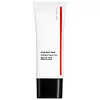What's inside
What's inside
 Key Ingredients
Key Ingredients

 Benefits
Benefits

 Concerns
Concerns

No concerns
 Ingredients Side-by-side
Ingredients Side-by-side

Water
Skin ConditioningMethyl Trimethicone
Skin ConditioningButylene Glycol
HumectantMethyl Methacrylate Crosspolymer
Dimethicone
EmollientPEG-10 Dimethicone
Skin ConditioningTriethylhexanoin
MaskingDiphenylsiloxy Phenyl Trimethicone
Skin ConditioningPolymethylsilsesquioxane
Caprylyl Methicone
Skin ConditioningTrifluoropropyldimethyl/Trimethylsiloxysilicate
EmollientCI 77120
Cosmetic ColorantSodium Chloride
MaskingDisteardimonium Hectorite
StabilisingPhenoxyethanol
PreservativeDisodium EDTA
Dipeptide-15
Skin ConditioningXanthan Gum
EmulsifyingChlorphenesin
AntimicrobialCellulose
AbsorbentCI 77891
Cosmetic ColorantMica
Cosmetic ColorantTocopherol
AntioxidantThymus Serpyllum Extract
Skin ConditioningDimethicone/PEG-10/15 Crosspolymer
Vinyl Dimethicone/Methicone Silsesquioxane Crosspolymer
Polyquaternium-51
Skin ConditioningStearic Acid
CleansingAluminum Hydroxide
EmollientZinc Oxide
Cosmetic ColorantHydrolyzed Conchiolin Protein
Skin ConditioningDimethicone/Vinyl Dimethicone Crosspolymer
Skin ConditioningAlumina
AbrasiveDipropylene Glycol
HumectantWater, Methyl Trimethicone, Butylene Glycol, Methyl Methacrylate Crosspolymer, Dimethicone, PEG-10 Dimethicone, Triethylhexanoin, Diphenylsiloxy Phenyl Trimethicone, Polymethylsilsesquioxane, Caprylyl Methicone, Trifluoropropyldimethyl/Trimethylsiloxysilicate, CI 77120, Sodium Chloride, Disteardimonium Hectorite, Phenoxyethanol, Disodium EDTA, Dipeptide-15, Xanthan Gum, Chlorphenesin, Cellulose, CI 77891, Mica, Tocopherol, Thymus Serpyllum Extract, Dimethicone/PEG-10/15 Crosspolymer, Vinyl Dimethicone/Methicone Silsesquioxane Crosspolymer, Polyquaternium-51, Stearic Acid, Aluminum Hydroxide, Zinc Oxide, Hydrolyzed Conchiolin Protein, Dimethicone/Vinyl Dimethicone Crosspolymer, Alumina, Dipropylene Glycol
Water
Skin ConditioningGlycerin
HumectantSodium Acrylates Crosspolymer-2
AbsorbentButylene Glycol
HumectantDipropylene Glycol
HumectantPentylene Glycol
Skin ConditioningSalix Alba Bark Extract
AstringentLaminaria Saccharina Extract
Skin ProtectingLactobacillus Ferment
Skin ConditioningNiacinamide
SmoothingTrimethylpentanediol/Adipic Acid/Glycerin Crosspolymer
Skin ConditioningAcetyl Glucosamine
Skin ConditioningSodium Hyaluronate
HumectantPyridoxine Hcl
Skin ConditioningZinc Sulfate
AntimicrobialPhenoxyethanol
PreservativeWater, Glycerin, Sodium Acrylates Crosspolymer-2, Butylene Glycol, Dipropylene Glycol, Pentylene Glycol, Salix Alba Bark Extract, Laminaria Saccharina Extract, Lactobacillus Ferment, Niacinamide, Trimethylpentanediol/Adipic Acid/Glycerin Crosspolymer, Acetyl Glucosamine, Sodium Hyaluronate, Pyridoxine Hcl, Zinc Sulfate, Phenoxyethanol
Ingredients Explained
These ingredients are found in both products.
Ingredients higher up in an ingredient list are typically present in a larger amount.
Butylene Glycol (or BG) is used within cosmetic products for a few different reasons:
Overall, Butylene Glycol is a safe and well-rounded ingredient that works well with other ingredients.
Though this ingredient works well with most skin types, some people with sensitive skin may experience a reaction such as allergic rashes, closed comedones, or itchiness.
Learn more about Butylene GlycolDipropylene Glycol is a synthetically created humectant, stabilizer, and solvent.
This ingredient helps:
Dipropylene glycol is technically an alcohol, but it belongs to the glycol family (often considered part of the ‘good’ alcohols). This means it is hydrating and gentle on skin unlike drying solvent alcohols like denatured alcohol.
As a masking agent, Dipropylene Glycol can be used to cover the smell of other ingredients. However, it does not have a scent.
Studies show Dipropylene Glycol is considered safe to use in skincare.
Learn more about Dipropylene GlycolPhenoxyethanol is a preservative that has germicide, antimicrobial, and aromatic properties. Studies show that phenoxyethanol can prevent microbial growth. By itself, it has a scent that is similar to that of a rose.
It's often used in formulations along with Caprylyl Glycol to preserve the shelf life of products.
Water. It's the most common cosmetic ingredient of all. You'll usually see it at the top of ingredient lists, meaning that it makes up the largest part of the product.
So why is it so popular? Water most often acts as a solvent - this means that it helps dissolve other ingredients into the formulation.
You'll also recognize water as that liquid we all need to stay alive. If you see this, drink a glass of water. Stay hydrated!
Learn more about Water